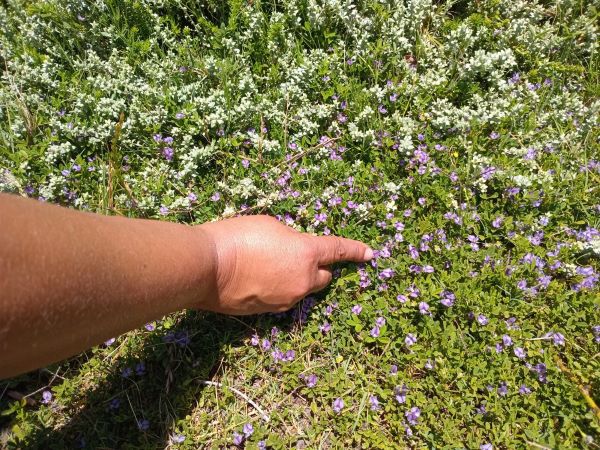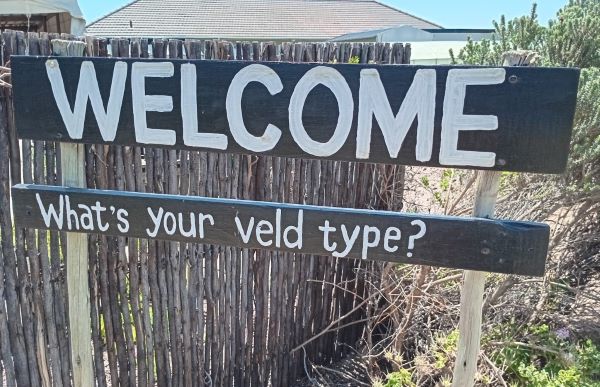| Back to Back Issues Page |
 |
|
Restore Nature, Issue #19 December 14, 2024 |
HelloRESTORE NATURE NEWSLETTERDecember 2024Dear gardeners and nature lovers Today you receive a link to the next module of the course on biodiversity gardening. Find it with the links at the bottom of the page. I intend making biodiversity a greater emphasis in this newsletter from now on. However, I have so much to learn. I hope you will enjoy learning with me. 
Pointing the way to biodiversity: some beautiful small things in the planted Fynbos circle After attending some planting days for stepping stone gardens, I was curious as to where the plants come from for planting out. One model is for numerous volunteers to grow the plants at home in 'home nurseries' or 'backyard nurseries'. I went to a workshop in Mowbray put on by Communitree on propagation from cuttings, and in the northern suburbs a workshop with Anel (with Valley Area Biodiversity on Whatsapp) on growing bulbs from seed and to one at the Tygerberg nature reserve by Rupert Koopman and Louise Ferreira (CID groening/greening on Whatsapp) which was also on growing bulbs from seed and doing cuttings. I'm still growing the plants whose seed they gave us. However the bulbs consitute only a small segment of the plants used during restoration-rehabilitation projects. I was interested to know where the bulk of the plants came from. 
Is this another sign ? I learned from asking at these events that many plants came from the two special nurseries in the Cape, at Muizenberg and Stellenbosch. My experience thus far has been working with commercial nurseries in my youth but restoration/rehabilitation nurseries are special. I wished to find out more about these crucial players in the battle against biodiversity loss, and meet the actors, the volunteer educators and plants people who make their work possible. 
I finally went to visit this place I'd heard so much about. This is where the questions started, and hopefullly a new branch of learning will grow well on the tree. Restoration/rehabilitation nurseries are not like commercial nurseries which produce plants, sell them on or put them out for sale to the public. The public market produces enormous pressure to supply what the public wants or knows of and to make a profit and breed showier varieties by selection and hybridization. This leads to a host of problems for our biodiversity at the Cape. Restoration/rehabilitation nurseries propagate wild unenhanced plants from very specific localities, to order, for specific projects. 
Fynbos education is lacking in most commercial nurseries, but Fynbos LIFE turn it into a feature, and education on the veld types features prominently. Cape Flats Sand Fynbos would have covered a huge area of what is now suburbia. Taking the profit motive out of the equation is very beneficial to biodiversity. It leads to the nurseries growing a suite of plants that build an ecosystem, rather than produce a spectacular show. It also means growing very locally indigenous plants which have co-evolved with the local fauna, and with each other. Insect host plants and other functional niches can be catered for instead of ignored due to the focus on appearance. 
A beautiful mix of plants is found in the veld circle at Fynbos LIFE. Its not the uptight manicured gardener's version of beauty. Tastes differ but I and certainly the wildlife which make it home would call this a version of paradise. At the Cape many native seeds one would want to plant require smoke to germinate, but there are a lot of other difficulties. I've found through watching biodiversity vlogs that this is the case with native plants all around the world. The nursery manager Victoria also stated that some fynbos plants are easy and some are very tricky. My experience in my home nursery has been exactly this. In addition wild seeds do not germinate on cue and may come up at different times. The commercial nurseries will be forced to produce plants that are easier to propagate, quick to germinate and produce conventionally attractive plants. 
The welcome and education I received at the Fynbos LIFE nursery is something I could rave about for a long time here, but nothing close to the precious time they gave me and my questions. I wondered about the job involved for those who have mastered propagating the tricky, less showy plants that are not interesting to commercial nurseries. To learn more I visited the 'Fynbos Life' nursery in Muizenberg. Eri-kah is the public educator there. Eri-kah is also a brilliant botanical photographer and her work can be seen on Pinterest. Lizar works on the children's education programs. Involving children can engage them for life, as seen in the northern suburbs too. Children are very inquisitive, receptive and enthusiastic and key to the intergenerational success of restoration. 
Some orange beetles are clearly enjoying the veld circle's sweet and colourful bounty Eri-kah took me to the Fynbos circle planted next to the nursery, where there is a sculpture of a butterfly, the critically endangered Barber's Cape Flats Ranger Butterfly, which had 50 remaining individuals and was predicted to become extinct within 5 years according to the Mohamed bin Zayed species conservation fund (in 2017) without drastic conservation efforts. Eri-kah explained that this beautiful butterfly is endangered because its host plant is a sedge which is seen as an ugly weed by gardeners. I didn't know about the plant connection, and that the host is a 'weed' and it made me so sad because it echoes stories about biodiversity loss from around the globe. We can learn so much from each other. Its another reason to leave the 'weeds' well alone. 
The famous sculpture of the critically endangered Barber's Cape Flats Ranger Butterfly. Such a sad reason to get your portrait done for posterity. Below you can find the article I wrote after going seed collecting with Fynbos LIFE, and realizing I need to get my re*... ation concepts sorted to better understand what they do, and what I'd like to do. Fynbos LIFE restoration-nursery.html benefits-of-biodiversity in a small public Renosterveld garden.html COURSE MODULE: Biodiversity-Garden-Design-basics-stage-2.html Topic suggestions welcomeYou may write to me anytime at the website greenidiom by filling out a comment. You can also use my webmail (website mail) address greenidi@greenidiom.com. Have you missed anything ?Please go to back issues right below if you want to catch up with what I've sent thus far as preamble for the course, as well as previous newsletters. |
| Back to Back Issues Page |